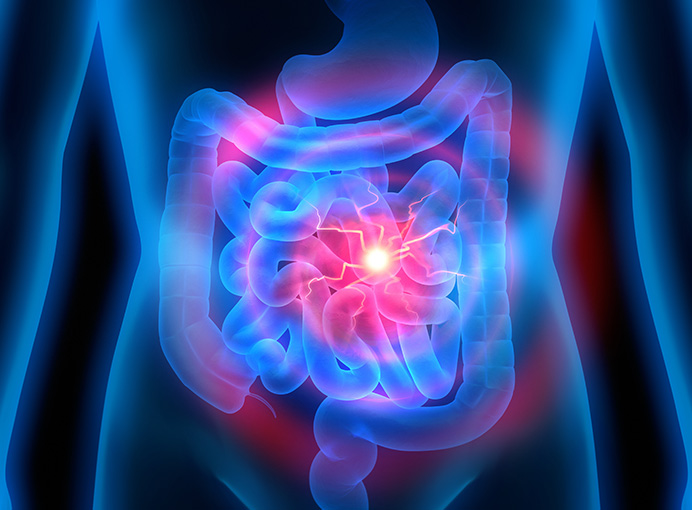Interleukin-2 Marks Variation in Celiac Disease Symptoms
By Van Waffle
New data shows how reactions to gluten vary among people with celiac disease. In a clinical study where 295 celiac disease patients voluntarily underwent a gluten challenge (10 grams of vital wheat gluten consumed quickly in a glass of water), almost one-third reported severe or very severe symptoms, one-third reported moderate symptoms, and one-third reported mild or very mild symptoms, while eight people reported no symptoms at all. For the first time, an immune biomarker, a measurable sign that detects the presence of a condition in the body, was found to correlate with how sick the patients felt, says lead author, Robert Anderson, MD, PhD, affiliated with Wesley Medical Research, The Wesley Hospital, Brisbane, Australia.
In most patients, symptom severity correlated with peak concentration of IL-2 in the blood.
The study tracked the release of an immune signal protein, Interleukin-2 (IL-2), for six hours following the gluten challenge. In most patients, symptom severity correlated with peak concentration of IL-2 in the blood. IL-2 is released by t-cells, white blood cells central to immune activity. In celiac disease, some t-cells become primed to respond to gluten. If such a t-cell detects gluten, one of the first things it does is secrete large amounts of IL-2 to signal an immune reaction.
According to Anderson, “IL-2 is a new discovery in celiac disease. Immunologists had overlooked IL-2, so it was a real surprise when we began to see IL-2 as being the most important and the earliest of the cytokines appearing in patients” after gluten exposure. The immune system uses cytokines, which are small proteins, to send signals between cells. “There are people who have reproducibly severe reactions and there are people who have much milder reactions,” he says. “The preliminary data suggests that strong reactions occur in people with larger numbers of t-cells circulating in their blood, but we don’t know why there’s such a big difference between individuals who are all on a gluten-free diet.”

In this study, symptoms consistently peaked around three hours after eating gluten, and had declined by half at the six hour point. Nausea, tiredness, and abdominal pain or cramping were each rated among the worst symptoms by about half of the patients. Gas, diarrhea, vomiting, and headache were less common. For those who reacted severely, nausea and vomiting were the worst symptoms. Diarrhea only occurred in severe and very severe reactions. Furthermore, IL-2 increased rapidly within two hours, peaking around four hours, and was elevated at nearly twice baseline levels in 78% of participants. Severity of symptoms correlated strongly with IL-2 levels in the blood. Of all recorded symptoms, nausea corresponded most closely with peak IL-2. Patients who vomited had 10 times more IL-2 than other patients. More IL-2 was associated with older age of the patient, older age at diagnosis, and genetic factors.
However, IL-2 levels remained normal in 65 of the 295 patients. The immune signal for their reactions remains unidentified. Their symptoms were comparable, varying from very mild to severe, but not very severe, and rarely included vomiting. Interestingly, all eight celiac patients who reported no symptoms showed elevated IL-2 after consuming gluten.
If proven as a biomarker, IL-2 could help diagnose and monitor celiac disease.
The study included a second gluten challenge five months later in 36 patients who followed a gluten-free diet in the interim. The severity of their first and second gluten reactions were similar, but vomiting affected more patients the second time, increasing from eight patients to 16, suggesting the severity of the response may increase with repeat exposures.
The findings from this study came from a clinical trial for the drug, Nexvax2, discontinued in 2019 because results showed it did not provide protection from gluten compared to a placebo. The study drew roughly half its participants from the United States and half from Australia and New Zealand, confirming that both populations reacted similarly to gluten. If proven as a biomarker, IL-2 could help diagnose and monitor celiac disease. Patients could skip the current diagnostic procedure of returning to a regular gluten-containing diet for several weeks and then undergoing a biopsy. Instead, they could take a single dose of gluten, followed a few hours later by a blood test. Elevated IL-2 might provide strong enough evidence of celiac disease. However, those lacking an IL-2 response would require further evaluation.
Anderson says the study “sharpens our focus on why people need a treatment for celiac disease, because a gluten-free diet does nothing for the severity of these acute reactions. Every part of the body is exposed to these pro-inflammatory cytokines. In a way, this gives you an objective marker of how severely unwell the celiac patient gets when they’re exposed.” It could also explain common, non-gastrointestinal symptoms, such as headache and fatigue.
Daniel Leffler, MD, PhD, associate professor of medicine at Beth Israel Deaconess Medical Center, Boston, cites Anderson’s study as emerging evidence for “different subgroups of patients in celiac disease,” not only in the level of symptoms, but how, specifically, the body reacts to gluten. “For some, the achievable gluten-free diet is going to be enough, and for some, it may not be,” Leffler says. “I think everyone deserves to be healthy despite their genetic and biological makeup and how they react to disease.”
Would you like to participate in celiac disease research? Add your data to our iCureCeliac® patient registry today. iCureCeliac® is a free online portal for patients, or their caregivers, to provide critical insights into life with celiac disease. Your participation will help create better diagnostic tools and treatments for cross-contact and gluten consumption, governmental policy changes, and access to new and innovative clinical trials nationwide, which may, one day, cure celiac disease.
